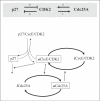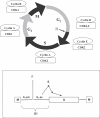From pathways databases to network models of switching behavior
- PMID: 17907792
- PMCID: PMC1994972
- DOI: 10.1371/journal.pcbi.0030152
From pathways databases to network models of switching behavior
Conflict of interest statement
Figures



Similar articles
-
A framework for elucidating regulatory networks based on prior information and expression data.Ann N Y Acad Sci. 2007 Dec;1115:240-8. doi: 10.1196/annals.1407.002. Epub 2007 Oct 9. Ann N Y Acad Sci. 2007. PMID: 17925352
-
Extracting active pathways from gene expression data.Bioinformatics. 2003 Oct;19 Suppl 2:ii238-44. doi: 10.1093/bioinformatics/btg1084. Bioinformatics. 2003. PMID: 14534196
-
LICORN: learning cooperative regulation networks from gene expression data.Bioinformatics. 2007 Sep 15;23(18):2407-14. doi: 10.1093/bioinformatics/btm352. Epub 2007 Aug 24. Bioinformatics. 2007. PMID: 17720703
-
Dissecting complex transcriptional responses using pathway-level scores based on prior information.BMC Bioinformatics. 2007 Sep 27;8 Suppl 6(Suppl 6):S6. doi: 10.1186/1471-2105-8-S6-S6. BMC Bioinformatics. 2007. PMID: 17903287 Free PMC article. Review.
-
Towards knowledge-based gene expression data mining.J Biomed Inform. 2007 Dec;40(6):787-802. doi: 10.1016/j.jbi.2007.06.005. Epub 2007 Jun 21. J Biomed Inform. 2007. PMID: 17683991 Review.
Cited by
-
Cell-cell communication in bacteria: united we stand.J Bacteriol. 2008 Jul;190(13):4377-91. doi: 10.1128/JB.00486-08. Epub 2008 May 2. J Bacteriol. 2008. PMID: 18456806 Free PMC article. Review. No abstract available.
-
Qualitative network modeling of the Myc-p53 control system of cell proliferation and differentiation.Biophys J. 2011 Nov 2;101(9):2082-91. doi: 10.1016/j.bpj.2011.09.052. Epub 2011 Nov 1. Biophys J. 2011. PMID: 22067145 Free PMC article.
-
Computational models in plant-pathogen interactions: the case of Phytophthora infestans.Theor Biol Med Model. 2009 Nov 12;6:24. doi: 10.1186/1742-4682-6-24. Theor Biol Med Model. 2009. PMID: 19909526 Free PMC article. Review.
-
An in silico modeling approach to understanding the dynamics of sarcoidosis.PLoS One. 2011;6(5):e19544. doi: 10.1371/journal.pone.0019544. Epub 2011 May 27. PLoS One. 2011. PMID: 21637752 Free PMC article.
-
MicroRNA regulation of a cancer network: consequences of the feedback loops involving miR-17-92, E2F, and Myc.Proc Natl Acad Sci U S A. 2008 Dec 16;105(50):19678-83. doi: 10.1073/pnas.0811166106. Epub 2008 Dec 9. Proc Natl Acad Sci U S A. 2008. PMID: 19066217 Free PMC article.
References
-
- Aguda BD, Craciun G, Cetin-Atalay R. Data sources and computational approaches for generating models of gene regulatory networks. Rev Comput Chem. 2005;21:381–411.
-
- Qi Y, Ge H. Modularity and dynamics of cellular networks. PLoS Comput Biol. 2006;2:e174. doi: 10.1371/journal.pcbi.0020174. - DOI - PMC - PubMed
-
- Aldridge BB, Burke JM, Lauffenburger DA, Sorger PK. Physicochemical modelling of cell signalling pathways. Nat Cell Biol. 2006;8:1195–1203. - PubMed
Publication types
MeSH terms
Substances
LinkOut - more resources
Full Text Sources

